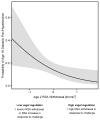Vagal Regulation of Cardiac Function in Early Childhood and Cardiovascular Risk in Adolescence
- PMID: 28207613
- PMCID: PMC5489373
- DOI: 10.1097/PSY.0000000000000458
Vagal Regulation of Cardiac Function in Early Childhood and Cardiovascular Risk in Adolescence
Abstract
Objective: Poor behavioral self-regulation in the first 2 decades of life has been identified as an important precursor of disease risk in adulthood. However, physiological regulation has not been well studied as a disease risk factor before adulthood. We tested whether physiological regulation at the age of 2 years, in the form of vagal regulation of cardiac function (indexed by respiratory sinus arrhythmia [RSA] change), would predict three indicators of cardiovascular risk at the age of 16 years (diastolic and systolic blood pressure and body mass index).
Methods: Data came from 229 children who participated in a community-based longitudinal study. At the age of 2 years, children were assessed for RSA baseline and RSA change (ln(ms)) in response to a series of challenge tasks. These same children were assessed again at the age of 16 years for diastolic and systolic blood pressure (millimeters of mercury), height (meters), and weight (kilogram).
Results: Regression analyses revealed that less RSA withdrawal at the age of 2 years predicted higher diastolic blood pressure at the age of 16 years, adjusting for demographic characteristics (B = -3.07, M [S E] = 1.12, p = .006). Follow-up analyses demonstrated that these predictions extended to clinically significant levels of diastolic prehypertension (odds ratio = 0.43, 95% confidence interval = 0.22-0.89). RSA withdrawal did not significantly predict adolescent body mass index or systolic blood pressure.
Conclusions: Vagal regulation of cardiac function in early childhood predicts select indicators of cardiovascular risk 14 years later. Early signs of attenuated vagal regulation could indicate an increased risk for elevated blood pressure before adulthood. Future research should test biological, behavioral, and psychological mechanisms underlying these long-term predictions.
Conflict of interest statement
Figures
References
-
- Din-Dzietham R, Liu Y, Bielo MV, Shamsa F. High blood pressure trends in children and adolescents in national surveys, 1963 to 2002. Circulation. 2007;116:1488–96. - PubMed
-
- Muntner P, He J, Cutler JA, Wildman RP, Whelton PK. Trends in blood pressure among children and adolescents. Jama. 2004;291:2107–13. - PubMed
-
- Ford ES, Capewell S. Coronary heart disease mortality among young adults in the U.S. from 1980 through 2002: Concealed leveling of mortality rates. J Am Coll Cardiol. 2007;50:2128–32. - PubMed
MeSH terms
Grants and funding
LinkOut - more resources
Full Text Sources
Other Literature Sources


